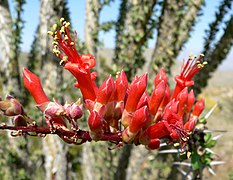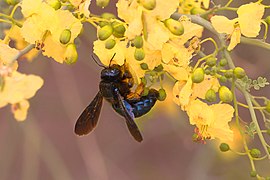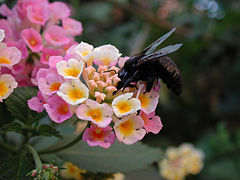California carpenter bee
| California carpenter bee | |
|---|---|

| |
| Female | |
| Scientific classification | |
| Domain: | Eukaryota |
| Kingdom: | Animalia |
| Phylum: | Arthropoda |
| Class: | Insecta |
| Order: | Hymenoptera |
| Family: | Apidae |
| Genus: | Xylocopa |
| Species: | X. californica
|
| Binomial name | |
| Xylocopa californica Cresson, 1864
| |
The California carpenter bee or Western carpenter bee, Xylocopa californica, is a species of carpenter bee in the order Hymenoptera, and it is native to western North America.[1]
Distribution
[edit]There are approximately 400 species worldwide of the genus Xylocopa.[2] X. californica is typically found in California, Nevada, Oregon, Washington, Utah, Arizona, New Mexico, Texas, and Northwestern Mexico, with outlying records in Montana, Kansas, and Louisiana.[3] It is especially abundant, along with X. sonorina, in the Central Valley and in Southern California, including the Mojave Desert. They are agriculturally beneficial insects and pollinators of diverse California chaparral and woodlands and desert native plant species.[4][5] This carpenter bee is active during hot seasons. Therefore, they are considered an endothermic insect as it absorbs heat in the desert conditions. As the bee absorbs too much heat in its body, it has to limit the time it flies and fly in the time of day in which it is cooler.[6]
Description
[edit]Their head is larger and thicker than their thorax; however, the size of the head differs between females and males. Female carpenter bees have bigger heads than males with more narrow heads.[7] The California carpenter bee is all black, with bluish/greenish reflections. The males typically have at least a few light hairs on the pronotum (dorsal prothorax) and the abdominal segments.[8] California carpenter bees have hair on their heads; most of their hair lays in the lower part of their head and cheeks compared to the sparse hairs on the top of the head. The female carpenter bees' hair is black, while the male carpenter bees' hair is yellow and yellowish colors.[7] They have dark wings without stigma and are 13–30 mm long overall.[2]
Foraging behavior
[edit]Xylocopa californica has been observed to rob nectar from ocotillo, Fouquieria splendens, and are determined to be their primary pollinator in the Big Bend National Park, Texas, USA.[9] They rob the nectar from flowers by chewing a hole on the side of the flower and taking the nectar without participating in pollination.[2] They like both nectar and pollen, except the pollen sources seem more specific; they prefer the pollen from the creosotebush (Larrea tridentata) and mesquite (Prosopis glandulosa).[10] They tend to visit larger open flowers due to their large size.[2] The foraging behavior consists of three movements- fast forward flight, hovering and perching or walking on the flower blossoms [11]
Floral sonication
[edit]Floral sonication is essential for the foraging of many Hymenoptera.[12] X. californica performs floral sonication to obtain pollen.[13] They do this by gripping the poricidal anthers with their mandibles and contracting their flight muscles, rapidly vibrating their body and the flower's anthers, releasing the pollen onto the abdomen and legs of the bees.[12] This process allows for pollination to happen.
The vibration frequency is different throughout their body; their head's natural vibration is 87 Hz, and their abdominal terga is 163 Hz.[13]X. californica can adjust its frequency to different types of flowers.[12]
Temperature regulation
[edit]Xylocopa californica inhabit the deserts of southwestern North America and endure high temperatures while they forage.[11] Foraging in these high temperatures may cause thermoregulatory problems for the bee, which is increased by the heat released from the muscular activity needed for their flight.[11] Unlike other insects, they can fly in temperatures as high as 48°C, which would be deadly for others, but can fly for a short period of time.[11] On the other hand, they can not withstand temperatures lower than 10-15 °C.[11]
Reproduction
[edit]Mating behavior
[edit]Xylocopa californica has many types of mating behaviors.[14] These include hovering near sites and chasing away other males, exhibiting female-defense polygyny.[14] Multiple males may try to grasp the female when she returns to the nest, then a struggle between the males may happen to be able to grasp the female midair to copulate; in particular, they look for virgin females because females only mate once in their lifetime.[14][15] After a few seconds, they separate, and the male returns to its hovering area.[15] Other males may patrol more than one nest and shuttle throughout many sites in a day.[14] If they are not patrolling the nests, then they may exhibit scramble competition at flowering sites, where they hope to catch a female.[14] The males are territorial, but they do not have a stinger.[2]
Nesting
[edit]Xylocopa californica carve their nest in wood.[2] They dig into the wood using their sharp mandibles while they vibrate their body- they do not eat the wood.[2] They dig a tunnel in substrates such as live or dead wood and hollow stems of the Yucca and Agave plants, then dig to the right and left, creating a T-shape nest.[2]
Their nest's success depends on the available pollen and nectar found in the area.[10] A suitable nest substrate is needed for their reproduction and survival; the quantity of stalks in the area is important in determining their total nest density.[10]
Predators
[edit]
Xylocopa californica does not have many predators, but in the southwest of Northern America, the ladder-backed woodpecker, Dendrocopos scalaria, has been observed to attack their nests.[10] And the bee fly, Anthrax simson, is a parasite of their nests [10]
There are reports of the honey bee, Apis mellifera, having negative effects on X. californica populations. The carpenter bees are attracted to the floral scents of the honey produced by the honey bees; X. californica may come near or inside their hives and get attacked by the hive resulting in the death of the carpenter bee.[16]
Disease
[edit]The fungus Ascosphaera apis is generally found in the larva of the European honey bee, Apis mellifera, causing the larva to be mummified.[17] It has also been found in X. californica, except the infected larva does not look the same as the honey bee's; they develop spore cysts beneath the larval integument.[17] X. californica are not the natural hosts of this fungus, but they may be infected if they visit the same plants as other infected honey bees.[17]
Subspecies
[edit]The species has three named subspecies, defined solely by coloration and geography:[1]
- Xylocopa californica arizonensis Cresson, 1879
- Xylocopa californica californica Cresson, 1864
- Xylocopa californica diamesa Hurd, 1954
Gallery
[edit]-
Female Xylocopa californica
-
Xylocopa californica
-
Xylocopa californica
-
Xylocopa californica
-
Xylocopa californica
References
[edit]- ^ a b "Xylocopa californica". Integrated Taxonomic Information System.
- ^ a b c d e f g h LeBuhn, G., & Pugh N. B. 2013. Field Guide to the Common Bees of California: Including Bees of the Western United States. University of California Press. 107(1): 98-99.
- ^ X. californica distribution map at DiscoverLife
- ^ California Insects; Jerry A. Powell, Charles L. Hogue; 1989; University of California Press.
- ^ Discoverlife.org: Xylocopa californica
- ^ Chappell, Mark A. (1982). "Temperature Regulation of Carpenter Bees (Xylocopa californica) Foraging in the Colorado Desert of Southern California". Physiological Zoology. 55 (3): 267–280. ISSN 0031-935X.
- ^ a b Ackerman, Arthur J. (1916). "The Carpenter-Bees of the United States of the Genus Xylocopa". Journal of the New York Entomological Society. 24 (3): 196–232. ISSN 0028-7199.
- ^ BugGuide.Net: Species − Xylocopa californica
- ^ Richardson, S.C. 2004. Are Nectar-robbers Mutualists or Antagonists?. Oecologia. 139: 246-254.
- ^ a b c d e Smith, W.E., and Whitford, W.G. 1978. Factors Affecting the Nesting Success of the Large Carpenter Bee, Xylocopa californica arizonensis '. Environmental Entomology. 7:614-616.
- ^ a b c d e Chappell, M.A. 1982. Temperature Regulation of Carpenter Bees (Xylocopa californica) Foraging in the Colorado Desert of Southern California. Physiological Zoology. 55: 267-280.
- ^ a b c Jankkauski, M., C. Casey., C. Heveran., M.K. Busby., S. Buchmann. 2022. Carpenter Bee Thorax Vibration and Force Generation Inform Pollen Release Mechanisms During Floral Buzzing. Scientific Reports. 12654.
- ^ a b King, M.J., and S.L., Buchmann. 2003. Floral Sonication by Bees: Mesosomal Vibration by Bombus and Xylocopa, but not Apis (Hymenoptera: Apidae), Ejects Pollen from Poricidal Anthers. Journal of the Kansas Entomological Society. 76: 295-305.
- ^ a b c d e Alock, John. 1991. Mate-Locating Behavior of Xylocopa californica arizonensis Cresson (Hymenoptera: Anthophoridae). Journal of the Kansas Entomological Society. 64: 349-356
- ^ a b Hurd Jr., P.D. 1958. Observations on the Nesting Habits of Some New World Carpenter Bees with Remarks on their Importance in the Problem of Species Formation (Hymenoptera: Apoidea). Annals Entomological Society of America. 51: 365- 375
- ^ Thoenes, S.C. 1993. Fatal Attraction of Certain Large-Bodied Native Bees to Honey Bee Colonies. Journal of the Kansas Entomological Society. 66: 210-213.
- ^ a b c Gilium, M., B. J. Lorenz., S. L., Buchmann. 1994. Ascosphaera apis, the Chalkbrood Pathogen of the Honey Bee, Apis mellifera, from Larvae of a Carpenter Bee, Xylocopa californica arizonensis. Journal of Invertebrate Pathology. 63: 307-309.
External links
[edit]- Discoverlife.org: Photo gallery of Xylocopa californica (Western Carpenter Bee) — with list of host plants.
- BugGuide.Net: Xylocopa californica — Western Carpenter Bee — images.
- Hymenoptera of North America
- Insects of Mexico
- Insects of the United States
- Fauna of California
- Fauna of the Southwestern United States
- Fauna of the California chaparral and woodlands
- Fauna of the Great Basin
- Fauna of the Mojave Desert
- Natural history of the Central Valley (California)
- Xylocopinae
- Insects described in 1864
- Taxa named by Ezra Townsend Cresson








